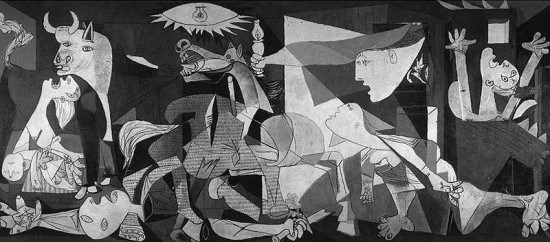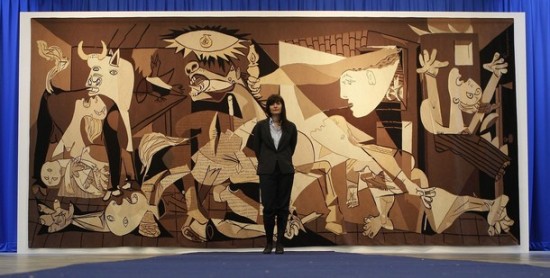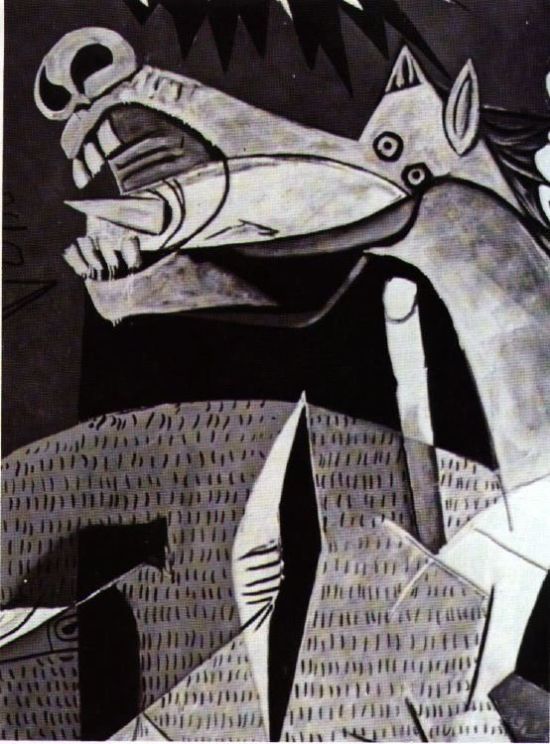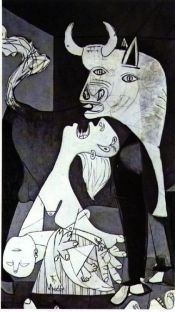Guernica by Picasso, 1936
April 15, 2009 at 7:47 pm | Posted in Art, Contemporary Art, Guernica, London Art, London Exhibitions, London Galleries, Pablo Picasso, Picasso's art work, Upcoming Exhibitions | 1 CommentTags: Art, Contemporary Art, Guernica, London Exhibitions, London Upcoming Exhibitions, Pablo Picasso, Picasso's art work, Spanish Civil War, Upcoming Exhibitions, Whitechapel Gallery
Pablo Picasso’s iconic mural denouncing the bombings of Guernika during the Spanish Civil War arrived last week to the city of London.
The Picasso-approved tapestry usually presides the United Nations building in New York but Londoners can now admire the Spaniard’s masterpiece at the Whitechapel Gallery.
The newly reopened East London gallery had already sheltered the celebrated Guernica in the year 1939 for two weeks. Back then, the price of entry had been, funnily enough, a pair of boots for the Republicans combatants in Spain.
Now, more than sixty years later, the Whitechapel gallery has secured a year loan of the life size Picasso replica that was first shown at the Spanish pavillon in the International Exposition dedicated to the Art and Technology in Modern Life held in Paris in 1937.
The original Guernica is now permanently exhibited at theMuseo Reina Sofía in Madrid considered to be too fragile to travel.
Guernica illustrates the cruelty of man and the horrors of war as well as being a personal tribute of the artist to the town of Gernika in Northern Spain after it was massacred by the Nazi Condor Legion during the Spanish Civil War.
This small village located in the Basque Country became the first victim of German deathly blitz as the town burnt for more than three days killing more than 200 innocent civilians.
Guernica is an overt anti-war statement that not only reflects the tragedy and the pain caused by war and man but also the grieving of an entire nation brought to its knees by Francisco Franco´s fascist forces.
Picasso’s masterpiece is not only brilliantly crafted and highly perfected in its technique but it is also powerful and moving charged with symbolism behind every figure that is featured in the mural.
The Spaniard employed dark colours and different scales of greys to emphasise the tragic mood and the destructing of the town that was reduced to ashes.
Several elements come together in Guernica aiming to portray the reality of Picass0’s days that led to the destruction of Europe in the most brutal world the world had ever seen.
Guernica’s symbolism is further emphasised by Picasso’s use of key elements in the Spanish popular culture such bulls and horses. These animals, as they appear mutilated and in great pain, serve to illustrate the defeat of the people in the hands of their tormentors.
A mother mourning for her lost child, burning bodies riped apart, figures in pain and distress, they all serve to illustrate the dehumanising power of war that reduced Gernika to flames.
Picasso’s masterpiece, Guernica, has effectively become the great anti-war manifesto destined to shake the apathy of people and the conscience of many who still regard war as a tool to seize power.
Visit Whitechapel Gallery, click here
Visit Museo Reina Sofía,click here.
Celebrated Guernica returns to London.
April 15, 2009 at 12:43 am | Posted in Art, Art World, Contemporary Art, London Art, London Art Scene, London Exhibitions, London Galleries, Pablo Picasso, Uncategorized, Whitechapel Gallery | Leave a commentTags: Art, Contemporary Art, Guernica, Guernika, London Art, London Contemporary Art, London Exhibitions, London Galleries, Pablo Picasso, Upcoming Exhibitions, Whitechapel Gallery
PICASSO’S DENUNCIATION OF WAR TO BE EXHIBITED AT THE WHITECHAPEL GALLERY.
The Guardian’s journalist Jonathan Glancey talks to Iwona Blazwick, director of the recently reopened Whitechapel art gallery, about Picasso’s masterpiece Guernica, its imminent return to London and the significance of the painting to the gallery.
Visit Whitechapel Gallery, click here.
Contact Whitechapel Gallery, click here.
Blog at WordPress.com.
Entries and comments feeds.






